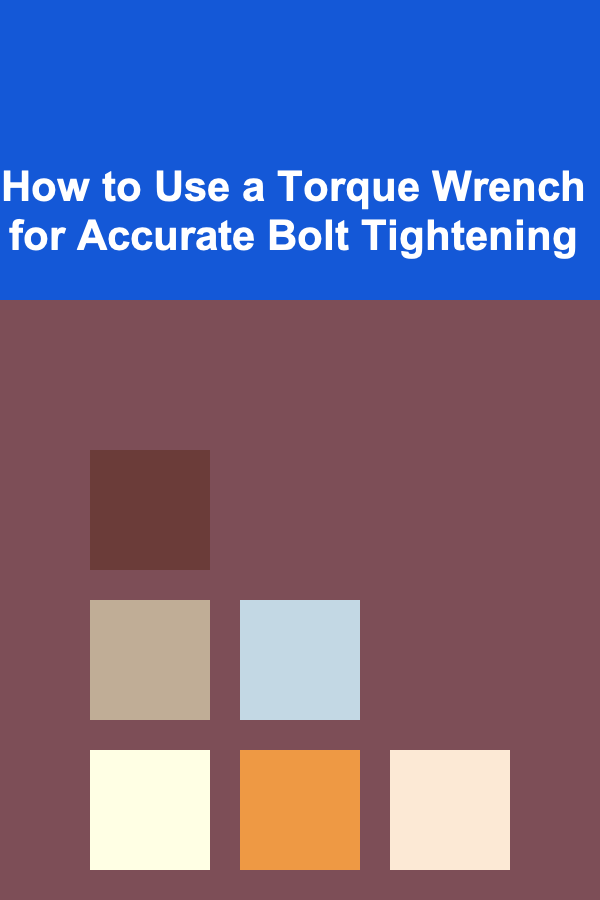
How to Use a Torque Wrench for Accurate Bolt Tightening
ebook include PDF & Audio bundle (Micro Guide)
$12.99$11.99
Limited Time Offer! Order within the next:

Accurate bolt tightening is crucial in a wide range of applications, from automotive repair to aircraft maintenance, and even in assembling furniture. Under-tightening a bolt can lead to joint failure, while over-tightening can strip threads or damage components. A torque wrench is the essential tool for achieving the correct tightness, ensuring both safety and longevity. This comprehensive guide will cover everything you need to know about torque wrenches, from understanding their purpose and types to mastering the techniques for accurate bolt tightening.
Understanding Torque and Bolt Tightening
Torque is a rotational force that causes an object to rotate. In the context of bolt tightening, torque is the force applied to a wrench that turns the bolt. The amount of torque applied is directly related to the clamping force that the bolt exerts, holding the joined materials together. The goal is to achieve the specified clamping force without exceeding the bolt's yield strength (the point where it permanently deforms) or falling short, leading to potential loosening.
Why is accurate torque so important? Consider the following:
- Preventing Joint Failure: Insufficient torque allows the joint to loosen under vibration or stress, potentially leading to catastrophic failure. * Avoiding Bolt Damage: Excessive torque can stretch the bolt beyond its elastic limit, causing it to weaken, strip threads, or even break. * Ensuring Consistent Performance: In applications where precise alignment or sealing is required (e.g., engine components), consistent torque ensures uniform pressure distribution. * Maintaining Warranty Compliance: Many manufacturers specify precise torque values for critical components. Using a torque wrench helps ensure compliance and protects the warranty.
Types of Torque Wrenches
Different types of torque wrenches are available, each with its own advantages and disadvantages. Choosing the right type depends on the application, frequency of use, and desired level of precision.
1. Click Torque Wrench
This is arguably the most common type of torque wrench. It features an internal mechanism that clicks or snaps audibly and/or tangibly when the preset torque value is reached.
Advantages:
- Relatively easy to use and understand. * Provides a clear indication when the desired torque is reached. * Available in a wide range of torque capacities and drive sizes (e.g., 1/4", 3/8", 1/2"). * Generally more affordable than other types.
Disadvantages:
- Can be less accurate than some other types if not properly calibrated and used. * Some models require resetting to zero after each use to maintain accuracy (check the manufacturer's instructions). * The clicking mechanism can wear out over time, affecting accuracy. * Can be difficult to use in noisy environments where the click may not be easily heard.
2. Beam Torque Wrench
This simple design features a beam that deflects when torque is applied. A pointer indicates the torque value on a scale. There are typically two types: a deflecting beam and a solid beam.
Advantages:
- Generally very accurate if properly calibrated. * Simple and durable design. * No complex internal mechanisms to wear out. * Relatively inexpensive. * Less sensitive to temperature changes.
Disadvantages:
- Can be difficult to read the scale accurately, especially in poorly lit areas or at awkward angles. * Requires a direct line of sight to the scale. * More susceptible to parallax error (the apparent shift in position of an object viewed from different angles). * Some users find them less convenient than click-type wrenches. * Can be more difficult to use one-handed.
3. Digital Torque Wrench
This type features a digital display that shows the applied torque value. Some models also offer features such as audible alarms, vibration alerts, and data logging.
Advantages:
- Highly accurate and precise. * Easy-to-read digital display. * Often includes multiple units of measurement (e.g., Nm, lb-ft, lb-in). * Some models have features like peak hold (which displays the maximum torque reached) and angle measurement. * Audible and/or tactile alerts when the target torque is reached. * Data logging capabilities for quality control and traceability.
Disadvantages:
- More expensive than other types. * Requires batteries. * Can be more sensitive to impacts and environmental conditions. * Can be more complex to use than click-type wrenches, requiring some familiarization.
4. Slip Torque Wrench
This type is pre-set to a specific torque value and "slips" or freewheels when that value is reached, preventing over-tightening. They are often used in production environments where consistent torque is critical.
Advantages:
- Virtually impossible to over-torque. * Ensures consistent torque across multiple fasteners. * Ideal for repetitive tightening tasks.
Disadvantages:
- Limited to a single, pre-set torque value. * Less versatile than adjustable torque wrenches. * Requires specialized tooling for calibration and adjustment.
5. Hydraulic Torque Wrench
Hydraulic torque wrenches use hydraulic pressure to generate high torque. They are commonly used for tightening large bolts in heavy-duty applications, such as oil and gas pipelines, bridges, and construction equipment.
Advantages:
- Capable of generating extremely high torque values. * Relatively compact and lightweight for their torque capacity. * Precise torque control.
Disadvantages:
- Expensive. * Requires a hydraulic power unit. * More complex to operate than other types of torque wrenches.
Choosing the Right Torque Wrench
Consider these factors when selecting a torque wrench:
- Torque Range: Ensure the wrench's torque range encompasses the values required for your applications. Avoid using a wrench at the extreme ends of its range, as accuracy can be compromised. Ideally, the required torque should fall within the middle 20-80% of the wrench's range. * Drive Size: Match the drive size (e.g., 1/4", 3/8", 1/2") to the size of the sockets you will be using. * Type of Application: For general use, a click-type wrench is often sufficient. For critical applications requiring high accuracy, consider a digital or beam-type wrench. For repetitive tasks, a slip torque wrench may be suitable. * Frequency of Use: If you will be using the wrench frequently, invest in a high-quality model that is durable and reliable. * Budget: Torque wrenches range in price from relatively inexpensive to very expensive. Balance your budget with the desired features and accuracy. * Calibration Requirements: Consider the cost and frequency of calibration. Some wrenches require more frequent calibration than others.
Preparing for Accurate Bolt Tightening
Proper preparation is crucial for achieving accurate torque. This includes inspecting the bolts and fasteners, cleaning the threads, and ensuring the correct lubrication.
1. Inspecting Bolts and Fasteners
Before tightening, carefully inspect the bolts, nuts, and washers for any signs of damage, such as:
- Stripped or damaged threads: Replace any bolts or nuts with damaged threads. * Corrosion or rust: Clean or replace corroded fasteners. Corrosion can affect torque readings. * Cracks or deformities: Discard any fasteners with cracks or deformities.
Using damaged fasteners can lead to inaccurate torque readings and potentially compromise the integrity of the joint.
2. Cleaning Threads
Clean the threads of both the bolt and the receiving hole or nut to remove any dirt, debris, or corrosion. Use a wire brush or thread chaser to clean the threads thoroughly. Clean threads ensure proper engagement and prevent false torque readings caused by friction.
3. Lubrication
Lubrication is essential for accurate torque. Most torque specifications are based on lubricated threads. The type of lubricant to use is usually specified by the manufacturer. If not, a general-purpose anti-seize compound or light oil is often suitable. Always refer to the manufacturer's recommendations for the correct lubricant.
Important Considerations Regarding Lubrication:
- Dry Torque vs. Wet Torque: Dry torque values are significantly higher than wet (lubricated) torque values. Never apply a dry torque value to a lubricated fastener or you risk over-tightening and damaging the bolt or joint. * Type of Lubricant: Using the wrong type of lubricant can significantly affect torque readings. Some lubricants are more effective at reducing friction than others. * Consistency: Apply the lubricant evenly to the threads. Uneven lubrication can lead to inconsistent torque readings. * Avoid Over-Lubrication: Excessive lubricant can cause hydraulic lock or interfere with the tightening process.
Setting and Using a Click Torque Wrench (Example)
Let's walk through the process of setting and using a click-type torque wrench, as it is the most common type.
1. Determining the Required Torque
Consult the manufacturer's specifications or a reliable torque chart to determine the correct torque value for the fastener. Torque values are typically expressed in units such as Newton-meters (Nm), pound-feet (lb-ft), or pound-inches (lb-in).
2. Setting the Torque Value
Most click-type torque wrenches have an adjustable scale that allows you to set the desired torque value. The exact mechanism for setting the torque varies depending on the model, but it usually involves turning a handle or dial. Some wrenches have a locking mechanism that must be disengaged before the torque can be adjusted.
Example: Let's say you need to tighten a bolt to 50 lb-ft. On most click-type wrenches, you would:
- Unlock the handle. * Turn the handle until the indicator line aligns with the 50 lb-ft mark on the scale. * Lock the handle to secure the setting.
3. Selecting the Correct Socket
Choose a socket that is the correct size for the nut or bolt head. Ensure the socket is clean and in good condition. A worn or damaged socket can slip, leading to inaccurate torque and potential damage.
4. Applying the Torque
Attach the socket to the torque wrench and place it squarely on the nut or bolt head. Apply smooth, steady pressure to the wrench handle. Avoid jerking or pulling on the wrench, as this can affect the accuracy of the torque reading. Pull the wrench in a smooth, controlled motion.
5. Listening for the Click
As you apply torque, listen carefully for the distinct "click" sound or feel the slight "snap" as the wrench reaches the preset torque value. This indicates that the desired torque has been achieved. Stop applying pressure immediately when you hear or feel the click. Continuing to apply pressure after the click will result in over-tightening.
6. Resetting the Wrench (If Required)
Some click-type torque wrenches are designed to be reset to the lowest setting after each use to relieve tension on the internal spring. Check the manufacturer's instructions to determine if your wrench requires resetting. Failing to reset the wrench (when required) can affect its accuracy over time.
Tips for Accurate Torque Tightening
Following these tips will help you achieve more accurate and consistent torque values:
- Use the Correct Wrench: Ensure you are using a torque wrench with the appropriate torque range for the application. * Calibrate Regularly: Have your torque wrench calibrated periodically by a qualified calibration service. The frequency of calibration depends on the frequency of use and the criticality of the application. As a general guideline, professional users should calibrate their wrenches every 3-6 months, while occasional users can calibrate annually. * Apply Steady Pressure: Avoid jerking or pulling on the wrench. Apply smooth, steady pressure to the handle. * Position Yourself Correctly: Stand or sit in a position that allows you to apply force squarely to the wrench handle. * Use Both Hands if Necessary: For larger torque wrenches, using both hands can provide better control and leverage. * Avoid Extensions: Using extensions between the torque wrench and the socket can affect the accuracy of the torque reading. If an extension is unavoidable, consult a torque conversion chart to adjust the torque setting accordingly. * Don't Use the Torque Wrench as a Breaker Bar: A torque wrench is designed for applying precise torque, not for breaking loose stubborn fasteners. Using it as a breaker bar can damage the wrench. * Keep the Wrench Clean: Clean the torque wrench regularly to remove dirt, grease, and debris. * Store the Wrench Properly: Store the torque wrench in a protective case or in a clean, dry environment to prevent damage. When storing a click-type wrench, always set it to its lowest torque setting (unless the manufacturer specifies otherwise) to relieve tension on the spring. * Double-Check Torque Values: Always verify the specified torque value before tightening. * Use a Torque Angle Gauge: For some applications, particularly those involving stretch bolts, torque plus angle tightening is required. This involves tightening the bolt to a specified torque and then rotating it a specified number of degrees. A torque angle gauge is used to measure the angle of rotation. * Understand Torque Correction Factors: In some cases, correction factors may be needed to account for factors such as the use of thread lubricants or different materials. Refer to engineering resources for guidance on applying correction factors.
Troubleshooting Common Issues
Here are some common problems encountered when using torque wrenches and how to address them:
- Inaccurate Torque Readings: Possible causes include a poorly calibrated wrench, incorrect torque setting, damaged fasteners, contaminated threads, or incorrect lubrication. Check all of these factors and recalibrate the wrench if necessary. * Wrench Not Clicking: If a click-type wrench is not clicking, it may be broken or the torque setting may be too low. Check the wrench for damage and increase the torque setting. If it still doesn't click at a setting well within the expected range, it needs repair or replacement. * Bolt Stripping: Stripped threads are usually caused by over-tightening. Use a lower torque value or ensure proper lubrication. If threads are already damaged, consider using a thread repair kit (e.g., Heli-Coil) or replacing the component. * Bolt Loosening: Loose bolts can be caused by insufficient torque, vibration, or improper assembly. Ensure the bolt is tightened to the correct torque and consider using thread-locking compounds (e.g., Loctite) to prevent loosening. * Difficulty Reading the Scale: If you're using a beam-type wrench, make sure the lighting is adequate and position yourself so you have a clear, direct line of sight to the scale.
Calibration and Maintenance
Regular calibration is essential to ensure the accuracy of your torque wrench. Calibration involves comparing the wrench's output to a known standard and adjusting it to meet specified accuracy tolerances.
Calibration Frequency:
- Professional Users: Calibrate every 3-6 months or after a significant impact or drop. * Occasional Users: Calibrate annually or as needed.
Maintenance Tips:
- Clean the wrench regularly with a soft cloth. * Store the wrench in a protective case to prevent damage. * Avoid exposing the wrench to extreme temperatures or humidity. * Have the wrench inspected and serviced by a qualified technician periodically. * Follow the manufacturer's recommendations for lubrication and maintenance.
Conclusion
Using a torque wrench correctly is essential for ensuring the integrity and safety of bolted joints. By understanding the principles of torque, choosing the right type of wrench, preparing the fasteners properly, and following the correct tightening procedures, you can achieve accurate and consistent torque values. Remember to calibrate your wrench regularly and follow the manufacturer's recommendations for maintenance to ensure its continued accuracy and reliability. Investing the time and effort to master these techniques will pay dividends in the form of improved performance, reduced risk of failure, and increased longevity of your equipment and assemblies. With practice and attention to detail, you can confidently and accurately tighten bolts to the specified torque, ensuring the reliability and safety of your work.

How to Manage Seasonal Maintenance for Your Rental Property
Read More
How To Use AI Tools for POD Design Inspiration
Read More
The Ultimate Guide to One-Page Website SEO Optimization
Read More
How to Utilize ChatGPT for Travel Planning
Read More
Conflict Resolution for Couples: Turning Disagreements into Growth
Read More
10 Tips for Financing a Luxury Vehicle: Options & Strategies
Read MoreOther Products

How to Manage Seasonal Maintenance for Your Rental Property
Read More
How To Use AI Tools for POD Design Inspiration
Read More
The Ultimate Guide to One-Page Website SEO Optimization
Read More
How to Utilize ChatGPT for Travel Planning
Read More
Conflict Resolution for Couples: Turning Disagreements into Growth
Read More